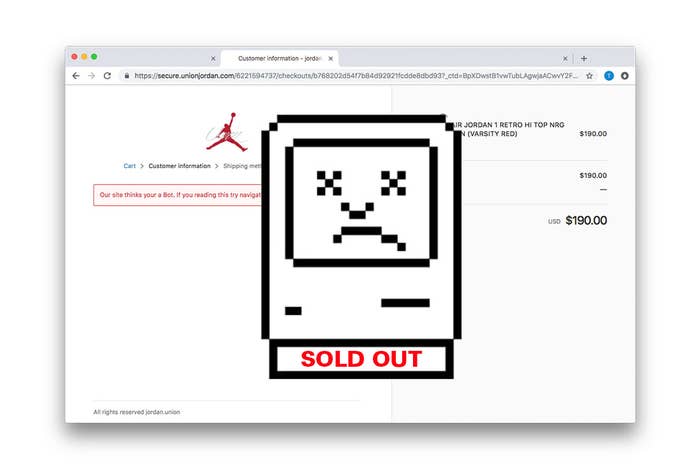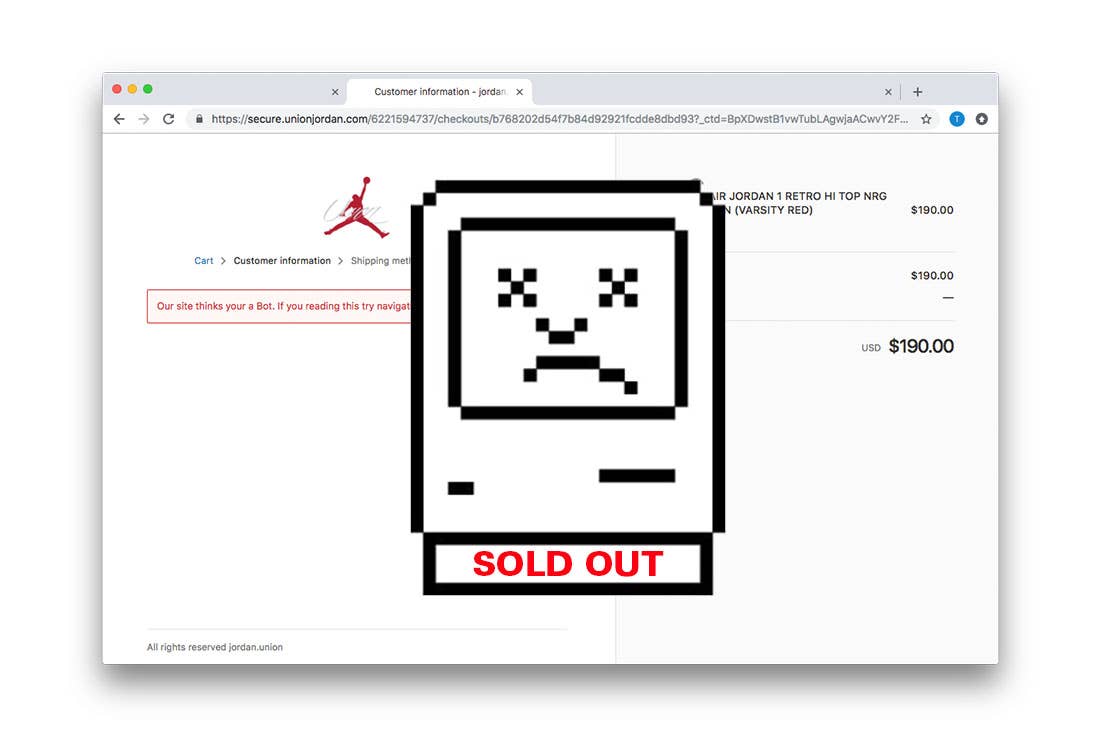
I’ve never seen a business where loyal customers anticipate not being able to buy anything.
In fact, lottery culture is as synonymous with sneaker and streetwear culture as the product retailers shell out on a weekly basis. But you’re not in line against the kid who spends all night camped out with his friends, now you’re up against against technology, where the camp-outs no longer work. The process is nearly sadistic at this point.
A little over five years ago, I wrote about my experience with purchasing a bot online for a pair of black-and-red Jordan 1s. The reception was mixed. Some folks understood that this was a part of the game, as if I was complaining, essentially telling me to suck it up and deal with this new world of consumerism. Others came to me with curiosity, wondering how bots worked, if it was simple, and if it was indeed effective. If I recall, I didn’t “cook” that day.
This certainly isn’t meant to glorify and blither on about the old days and how face-to-face interactions, personal relationships, comfortable folding chairs, and blankets on cold nights all contributed to the cultivation of the “culture” we know and love today.
But back then, consumers felt as if the playing field was even, or, at least, that they had a chance. The interaction with the person that brought out the kicks for you meant everything, you established interpersonal relationships with the boutique owner or the guy behind the counter. Surely, these elements of the merchant/consumer relationship still exist today, however it seems as if the essence of sneaker shopping has long departed.
Without going into the technicalities of add-to-carts, proxies, and other methods of ecommerce automation, just know that websites ranging from the small mom-and-pop boutiques, all the way to mega corporations like Nike and Adidas, have all been affected at any given release. “Cook Groups”—or chat room dedicated to divulging site info, drop times, and other release related activity—now run the show.
Some cats make a decent living conjuring up the scripts to get around whatever obstacles developers on the other end throw their way. The economy is so robust that not only is reselling a viable route to make money, but selling code to people that otherwise would never use javascript now fetches up to a few hundred dollars—depending on exclusivity. Your lone entry is now up against tens or hundreds of entries from the same person. This makes the waters murkier, because you not only need to know where to get the kicks, but you must now know how to navigate places like Reddit, online forums, and social media to find a source to connect you with the proper tools to purchase what you desire.
It isn’t to say that retailers haven’t tried to combat bots.
SNKRS was originally intended to help Nike funnel a once shambolic dot com experience into a more mobile-centric, secure, and fair system on release days. Since its introduction, there have been various upgrades to the platform, including AR and Stash, a scavenger hunt style geolocation method designed to throw bots off of the scent and provide consumers with a chance to cop their favorite shoes. Shopify, a platform that serves the likes of Kith, and Adidas Reserved also have had their respective peaks and valleys. “The only way they try to combat bots these days is through naming the product or link without mentioning the product at all,” says Jonathan Chambers, a Toronto-based collector who occasionally flips Kith and Supreme gear online.
Major brands have also used unique methods for sneaker drops. Artist Tom Sachs created Space Camp to coincide with the release of his Nike collab, asking buyers to work for their kicks by completing an obstacle before getting to their Mars Yards. In a recent drop with Acronym, Nike used a virtual scratch off system to help peeps get their Prestos.
Perhaps companies should return to non-scheduled releases. Just drop the shoe and allow the playing field to really be even. Retailers like Concepts and Undefeated have all moved to smaller capsule collections, pop-up shops, and raffles to differentiate themselves from others who release product traditionally.
The other more cynical question is, do retailers care?
When asked, Quinton Brown, an established collector and security analyst for an unnamed government agency in Washington, D.C., says, “Yes and no, I think some retailers like when their sites crash because it builds more hype. Retailers could easily hire a better development team to combat the use of bots.”
The product is moving and fiscal goals are being met. One would like to think that brands would cater to the needs of the customer and take our gripes into consideration. But, it’s difficult to say whether this is the case. “It will be a cat and mouse game until one or the other gives up,” says James Winters, a Kansas City-based collector who uses bots for every major release.
It’s now seen as a must that you need a bot. Copping “manually” is a risky endeavor—a misstep in entering credit card info or your address could mean that the item that was once on its way to being delivered to your door is now swept from under your virtual feet. That very sequence has happened to so many customers at this point that it’s now a part of the release date experience, and there is seemingly no light at the end of the tunnel.
The exclusivity will always be there in the world of streetwear, and it’s quite possible that the exclusivity is what drives brands to stay the course in regards to how they handle not only the availability, but the probability of purchasing their product. After all, the hype doesn’t follow every sneaker. The issue remains that the playing field must be even, especially in the digital realm. The old phrase is that the customer is always right, but what happens if the customer is a mindless bot?

